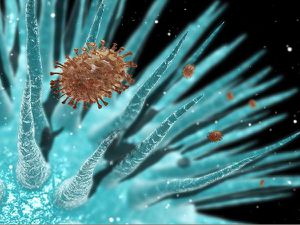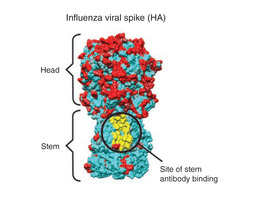Influenza Vaccine: Difference between revisions
| Line 17: | Line 17: | ||
<br> <br> | <br> <br> | ||
== | ==Antigenic drift and new vaccine targets== | ||
The influenza virus evolves in response to the antibodies produced by our bodies. In a process called antigenic drift, virus particles with mutations that allow them to evade attack by common antibodies are selected for by natural selection. These "fit" mutants spread to new people, and new strains evolve.<br><br> | |||
[[Image:Hemagglutinin.jpg|thumb|300px|right|Influenza virus spike. http://www.nature.com/nm/journal/v16/n12/full/nm1210-1389.html]] | |||
The current vaccines produce antibodies that recognize a protein on the outer coating of the virus called hemagglutinin, focusing on the "head" region of the molecule (see figure 2). But this "head" region is a part of the virus that is very susceptible to antigenic drift. | |||
[[Image:Hemagglutinin.jpg|thumb|300px|right|Figure 2. Influenza virus hemagglutinin spike. http://www.nature.com/nm/journal/v16/n12/full/nm1210-1389.html]] | |||
==Section 2== | ==Section 2== | ||
Revision as of 22:11, 5 November 2013
Introduction
The influenza vaccine is a highly controversial vaccine, and has several unique qualities that make it an especially interesting topic of research.
Vaccines work by exposing the body to the right antibodies to fight a particular disease. (more about how vaccines work)
But, the influenza virus is a rapidly evolving pathogen. The virus evolves enough from season to season that a new dose of the vaccine is necessary every year, as last year's antibodies usually can not recognize this year's strain. See antigenic drift section.

Other examples:
Bold
Italic
Subscript: H2O
Superscript: Fe3+
Antigenic drift and new vaccine targets
The influenza virus evolves in response to the antibodies produced by our bodies. In a process called antigenic drift, virus particles with mutations that allow them to evade attack by common antibodies are selected for by natural selection. These "fit" mutants spread to new people, and new strains evolve.
The current vaccines produce antibodies that recognize a protein on the outer coating of the virus called hemagglutinin, focusing on the "head" region of the molecule (see figure 2). But this "head" region is a part of the virus that is very susceptible to antigenic drift.

Section 2
Include some current research, with a second image.
Conclusion
Overall text length should be at least 1,000 words (before counting references), with at least 2 images. Include at least 5 references under Reference section.
References
Edited by [Author Name], student of Joan Slonczewski for BIOL 116 Information in Living Systems, 2013, Kenyon College.
